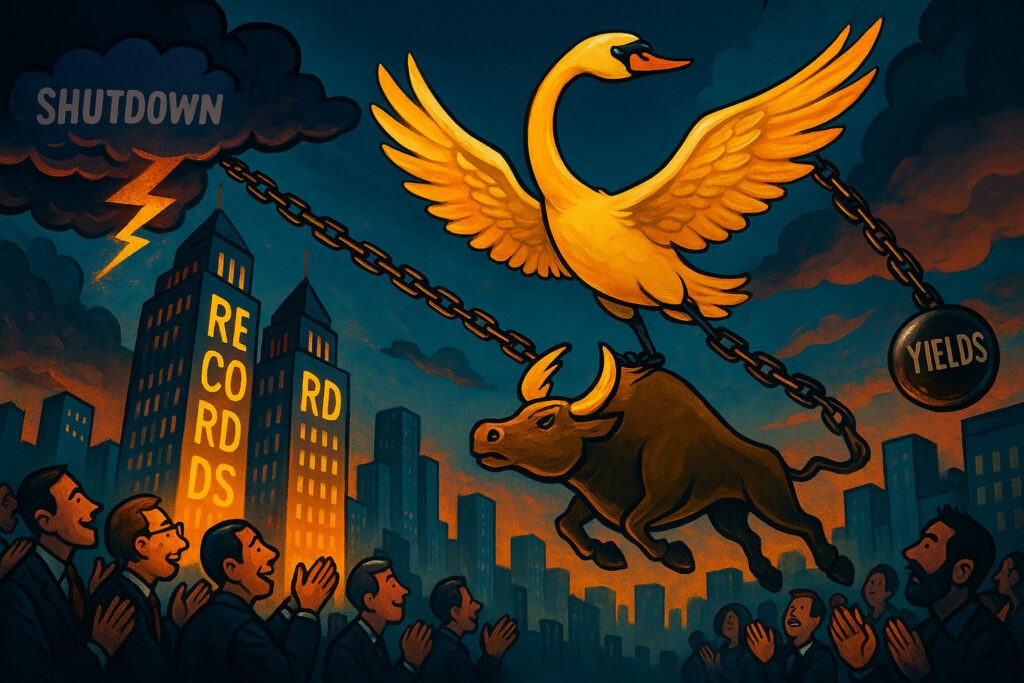Introduction
On 30 September 2025, U.S. markets closed out the month on a cautiously optimistic note, edging higher even as the threat of a government shutdown loomed large. The Dow Jones Industrial Average hit a fresh record close, while both the S&P 500 and Nasdaq Composite logged gains. It was a third straight day of advances. Investors appeared willing to shrug off fiscal uncertainty—at least momentarily—as they leaned into momentum, tech strength, inflation data, and the prospect of continued Fed easing.
Yet beneath the veneer of record highs lay unresolved tensions: inflation remains sticky, bond yields hold dangerous ground, consumer confidence is slipping, and the shutdown threatens to obscure the flow of vital economic data. As September turns to October, markets stand at a delicate summit.
Body
Markets Rally Despite Shutdown Fears
Stocks rallied broadly. The S&P 500 climbed roughly 0.4%, while the Nasdaq added around 0.3%, and the Dow rose about 0.2%, closing at a fresh record. All 11 sectors in the S&P ended in positive territory. The Dow’s record close was a symbolic nod to enduring momentum even as politics intrude deeper into market calculations.
Investors set aside shutdown jitters in favor of strength in technology, financials, and discretionary sectors. The technology sector, in particular, drove gains, led by large-cap names regaining footing. Meanwhile, breadth improved modestly, indicating that gains were not solely concentrated in the behemoths.
The rally suggested that sentiment—not fundamentals—was still a powerful force. Many traders seemed to bet that any shutdown, even if painful, will prompt accommodative policy or temporary extensions.
Inflation & Yields: The Persistent Constraint
The inflation backdrop loomed large. Though new CPI or PCE prints were not released that day, August’s CPI YoY of 2.9% and core CPI of 3.1% remain reference points. These numbers continue to constrain how aggressively the Fed can act.
Bond markets remained taut. The 10-year Treasury yield drifted upward to around 4.15%, and short yields held firm. The yield curve remained compressed. Despite the rally in equities, the bond markets did not entirely bow to the optimism.
Dallas Fed President Lorie Logan cautioned that inflation is not convincingly on a path back to 2%, and that while demand has softened, non-housing services inflation remains stubbornly elevated. Her remarks reinforced the idea that future rate cuts will likely be gradual and data-dependent.
Thus, equities are rallying—but in the shadow of yield resistance. Growth stocks, in particular, remain vulnerable to discount rate pressure if yields creep higher again.
Consumer Confidence: A Fading Anchor
Consumer outlook took another hit. The Conference Board’s Consumer Confidence Index fell by 3.6 points in September, to 94.2, down from 97.8 the prior month. The deteriorating expectations component (reading of 73.4) remained below the threshold (80) that typically signals elevated recession risk. Meanwhile, the present conditions index dropped sharply to 125.4.
These declines suggest households are growing more pessimistic about jobs, incomes, and business conditions—ironically just as stocks flirt with highs. If consumers pull back, corporate revenues could feel the strain, exposing the disconnect between markets and Main Street.
Shutdown Overhang & Data Silence
One of the most significant headwinds is the looming U.S. government shutdown. With the shutdown potentially halting operations across federal agencies, key data releases—jobs, inflation, retail sales, GDP—could be delayed or suspended entirely. The non-farm payroll report, scheduled for early October, hangs in doubt.
Without these data, the Federal Reserve may be forced to rely more heavily on private indicators and nowcasts—a risk when policy decisions hinge on clarity. Markets price forward-looking policy moves; when visibility is occluded, volatility often rises.
In short, equities are dancing without seeing the floor. The absence of confirmed data could magnify missteps ahead.
Sector Rotation & Market Psychology
The 30 September session reflected rotation and recalibration. While tech led, financials and consumer discretionary also joined the advance. Energy underperformed, pressured by falling oil prices (Brent slipped about 1.3%) and increased supply expectations.
Defensive names—utilities, staples, healthcare—held more stable, providing ballast. Real estate saw mixed action, battered by rate sensitivity but modestly helped by yield relief.
Investor psychology was evident in flows: bulls returned to risk assets, but safe-haven positions held their ground. Many portfolios appeared barbell-structured: exposure to growth, hedges in Treasuries and gold.
Global Signals & External Pressures
International markets offered subtle signals that reinforce U.S. tension. In China, the PMI index rose to 49.8, up from 49.4 in August, though still below the 50 threshold. This slight uptick suggests a modest stabilization but not full recovery.
Currency markets moved in tandem with rate differentials and risk sentiment. The U.S. dollar index was modestly lower, undercut by global demand for risk assets. The yen gained as a relative safe haven amid uncertainty. Emerging markets were bifurcated—commodity exporters saw some strength, while import-heavy currencies remained under pressure.
Oil markets reacted to supply expectations: OPEC+ moves and resumed exports from Iraq’s Kurdistan region damped prices. Crude slipped, adding headwinds for energy equities.
Conclusion
30 September 2025 was a moment of both triumph and tension. Markets closed strongly—with the Dow setting a new record, and the S&P and Nasdaq extending their September gains—despite mounting fiscal uncertainty and yield pressure. Investors bet on resolve: that momentum and policy expectations would outpace volatility.
Yet unresolved risks linger: inflation above target, stubborn yields, consumer distress, and the threat of data blackouts from a shutdown. The rally is not void of danger—it’s riding a knife’s edge.
Key Questions Ahead
- Will Sept. inflation prints provide surprises that reshape Fed expectations?
- Can equities sustain rally trajectories without confirmation from consumer demand or employment?
- How far can yields climb before valuation pressure triggers rotation or reversal?
- What is the market’s fallback if data releases vanish during a shutdown?
- Will global strains—China, commodity swings, currency flux—amplify domestic fragilities?
As September turns to October, 30 September 2025 may be remembered as a high-water mark: a market surge limned in shadows, pushing toward new summits even as storm clouds gather.
